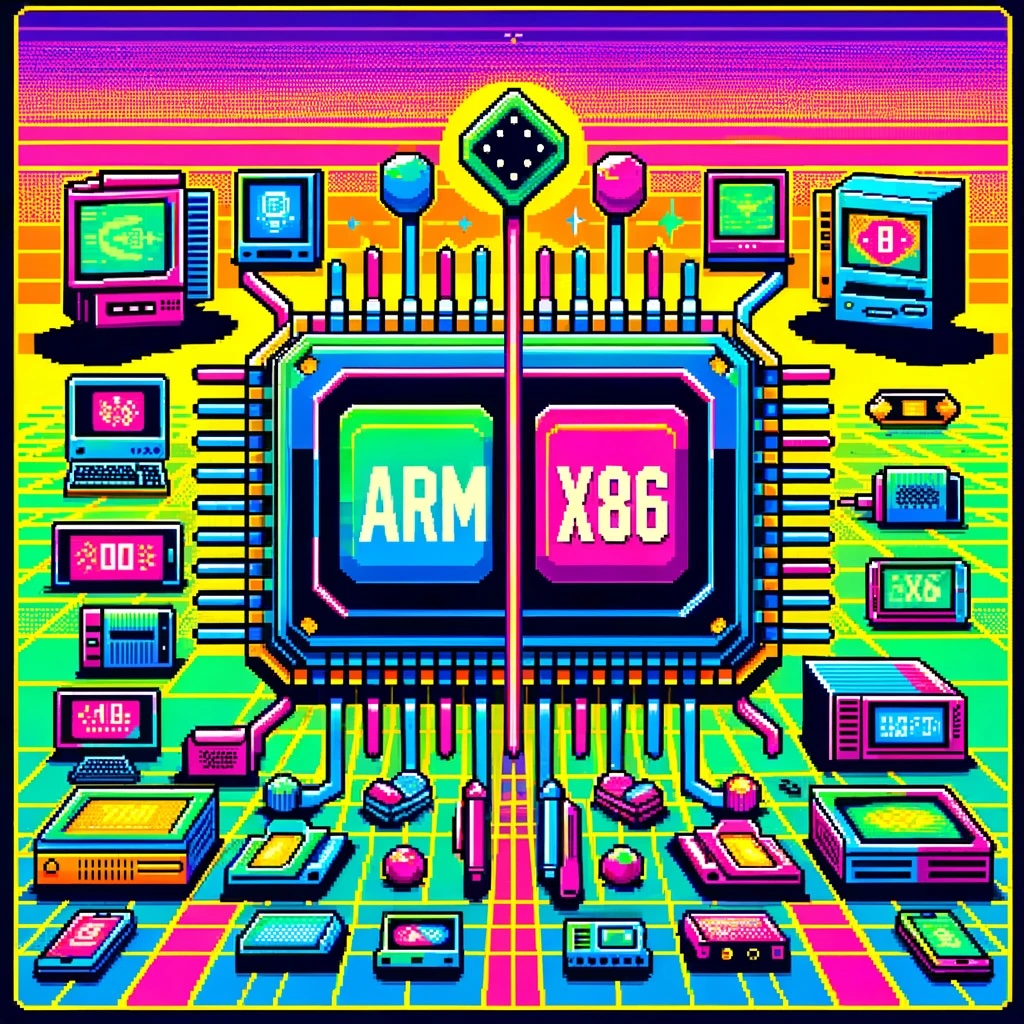
by Joche Ojeda | May 23, 2024 | CPU
The world of CPU architectures is diverse, with ARM and x86 standing out as two of the most prominent types. Each architecture has its unique design philosophy, use cases, and advantages. This article delves into the intricacies of ARM and x86 architectures, their applications, key differences, and highlights an area where x86 holds a distinct advantage over ARM.
ARM Architecture
Design Philosophy:
ARM (Advanced RISC Machines) follows the RISC (Reduced Instruction Set Computer) architecture. This design philosophy emphasizes simplicity and efficiency, using a smaller, more optimized set of instructions. The goal is to execute instructions quickly by keeping them simple and minimizing complexity.
Applications:
- Mobile Devices: ARM processors dominate the smartphone and tablet markets due to their energy efficiency, which is crucial for battery-operated devices.
- Embedded Systems: Widely used in various embedded systems like smart appliances, automotive applications, and IoT devices.
- Servers and PCs: ARM is making inroads into server and desktop markets with products like Apple’s M1/M2 chips and some data center processors.
Instruction Set:
ARM uses simple and uniform instructions, which generally take a consistent number of cycles to execute. This simplicity enhances performance in specific applications and simplifies processor design.
Performance:
- Power Consumption: ARM’s design focuses on lower power consumption, translating to longer battery life for portable devices.
- Scalability: ARM cores can be scaled up or down easily, making them versatile for applications ranging from small sensors to powerful data center processors.
x86 Architecture
Design Philosophy:
x86 follows the CISC (Complex Instruction Set Computer) architecture. This approach includes a larger set of more complex instructions, allowing for more direct implementation of high-level language constructs and potentially fewer instructions per program.
Applications:
- Personal Computers: x86 processors are the standard in desktop and laptop computers, providing high performance for a broad range of applications.
- Servers: Widely used in servers and data centers due to their powerful processing capabilities and extensive software ecosystem.
- Workstations and Gaming: Favored in workstations and gaming PCs for their high performance and compatibility with a wide range of software.
Instruction Set:
The x86 instruction set is complex and varied, capable of performing multiple operations within a single instruction. This complexity can lead to more efficient execution of certain tasks but requires more transistors and power.
Performance:
- Processing Power: x86 processors are known for their high performance and ability to handle intensive computing tasks, such as gaming, video editing, and large-scale data processing.
- Power Consumption: Generally consume more power compared to ARM processors, which can be a disadvantage in mobile or embedded applications.
Key Differences Between ARM and x86
- Instruction Set Complexity:
- ARM: Uses a RISC architecture with a smaller, simpler set of instructions.
- x86: Uses a CISC architecture with a larger, more complex set of instructions.
- Power Efficiency:
- ARM: Designed to be power-efficient, making it ideal for battery-operated devices.
- x86: Generally consumes more power, which is less of an issue in desktops and servers but can be a drawback in mobile environments.
- Performance and Applications:
- ARM: Suited for energy-efficient and mobile applications but increasingly capable in desktops and servers (e.g., Apple M1/M2).
- x86: Suited for high-performance computing tasks in desktops, workstations, and servers, with a long history of extensive software support.
- Market Presence:
- ARM: Dominates the mobile and embedded markets, with growing presence in desktops and servers.
- x86: Dominates the desktop, laptop, and server markets, with a rich legacy and extensive software ecosystem.
An Area Where x86 Excels: High-End PC Gaming and Specialized Software
One key area where x86 can perform tasks that ARM typically cannot (or does so with more difficulty) is in running legacy software that was specifically designed for x86 architectures. This is particularly evident in high-end PC gaming and specialized software.
High-End PC Gaming:
- Compatibility with Legacy Games:
- Many high-end PC games, especially older ones, are optimized specifically for x86 architecture. Games like “The Witcher 3” or “Crysis” were designed to leverage the architecture and instruction sets provided by x86 CPUs.
- These games often make extensive use of the complex instructions available on x86 processors, which can directly translate to better performance and higher frame rates on x86 hardware compared to ARM.
- Graphics and Physics Engines:
- Engines such as Unreal Engine or Unity are traditionally optimized for x86 architectures, making the most of its processing power for complex calculations, realistic physics, and detailed graphics rendering.
- Advanced features like real-time ray tracing, high-resolution textures, and complex AI calculations tend to perform better on x86 systems due to their raw processing power and extensive optimization for the architecture.
Specialized Software:
- Enterprise Software and Legacy Applications:
- Many enterprise applications, such as older versions of Microsoft Office, Adobe Creative Suite, or proprietary business applications, are built specifically for x86 and may not run natively on ARM processors without emulation.
- While ARM processors can emulate x86 instructions, this often comes with a performance penalty. This is evident in cases where businesses rely on legacy software that performs crucial tasks but is not available or optimized for ARM.
- Professional Tools:
- Professional software such as AutoCAD, certain versions of MATLAB, or legacy database management systems (like some older Oracle Database setups) are heavily optimized for x86.
- These tools often use x86-specific optimizations and plugins that may not have ARM equivalents, leading to suboptimal performance or compatibility issues when running on ARM.
Conclusion
ARM and x86 architectures each have their strengths and are suited to different applications. ARM’s power efficiency and scalability make it ideal for mobile devices and embedded systems, while x86’s processing power and extensive software ecosystem make it the go-to choice for desktops, servers, and high-end computing tasks. Understanding these differences is crucial for selecting the right architecture for your specific needs, particularly when considering the performance of legacy and specialized software.

by Joche Ojeda | Mar 8, 2024 | Uncategorized
Navigating the Challenges of Event-Based Systems
Event-based systems have emerged as a powerful architectural paradigm, enabling applications to be more scalable, flexible, and decoupled. By orchestrating system behaviors through events, these architectures facilitate the design of responsive, asynchronous systems that can easily adapt to changing requirements and scale. However, the adoption of event-based systems is not without its challenges. From debugging complexities to ensuring data consistency, developers must navigate a series of hurdles to leverage the full potential of event-driven architectures effectively. This article delves into the critical challenges associated with event-based systems and provides insights into addressing them.
Debugging and Testing Complexities
One of the most daunting aspects of event-based systems is the complexity involved in debugging and testing. The asynchronous and decoupled nature of these systems makes it challenging to trace event flows and understand how components interact. Developers must adopt sophisticated tracing and logging mechanisms to visualize event paths and diagnose issues, which can significantly increase the complexity of testing strategies.
Ensuring Event Ordering
Maintaining a correct sequence of event processing is crucial for the integrity of an event-based system. This becomes particularly challenging in distributed environments, where events may originate from multiple sources at different times. Implementing mechanisms to ensure the orderly processing of events, such as timestamp-based ordering or sequence identifiers, is essential to prevent race conditions and maintain system consistency.
Complex Error Handling
Error handling in event-driven architectures requires careful consideration. The loose coupling between components means errors need to be communicated and handled across different parts of the system, often necessitating comprehensive strategies for error detection, logging, and recovery.
Latency and Throughput Challenges
Balancing latency and throughput is a critical concern in event-based systems. While these architectures can scale effectively by adding more consumers, the latency involved in processing and reacting to events can become a bottleneck, especially under high load conditions. Designing systems with efficient event processing mechanisms and scaling strategies is vital to mitigate these concerns.
Mitigating Event Storms
Event storms, where a flood of events overwhelms the system, pose a significant risk to the stability and performance of event-based architectures. Implementing back-pressure mechanisms and rate limiting can help control the flow of events and prevent system overload.
Dependency Management
Although event-based systems promote decoupling, they can also introduce complex, hidden dependencies between components. Managing these dependencies requires a clear understanding of the event flow and interactions within the system to avoid unintended consequences and ensure smooth operation.
Data Consistency and Integrity
Maintaining data consistency across distributed components in response to events is a major challenge. Event-based systems often require strategies such as event sourcing or implementing distributed transactions to ensure that data remains consistent and accurate across the system.
Security Implications
The need to secure event-driven architectures cannot be overstated. Events often carry sensitive data that must be protected, necessitating robust security measures to ensure data confidentiality and integrity as it flows through the system.
Scalability vs. Consistency
Event-based systems face the classic trade-off between scalability and consistency. Achieving high scalability often comes at the cost of reduced consistency guarantees. Finding the right balance based on system requirements is critical to the successful implementation of event-driven architectures.
Tooling and Monitoring
Effective monitoring and management are essential for maintaining the health of an event-based system. However, the lack of visibility into asynchronous event flows and distributed components can make monitoring challenging. Selecting the right set of tools that offer comprehensive insights into the system’s operation is crucial.
Conclusion
While event-based systems offer numerous advantages, successfully implementing them requires overcoming a range of challenges. By understanding and addressing these challenges, developers can build robust, scalable, and efficient event-driven architectures. The key lies in careful planning, adopting best practices, and leveraging appropriate tools and technologies to navigate the complexities of event-based systems. With the right approach, the benefits of event-driven architecture can be fully realized, leading to more responsive and adaptable applications.

by Joche Ojeda | Dec 6, 2023 | A.I
Decision Trees and Naive Bayes Classifiers
Decision Trees
Overview:
- Decision trees are a type of supervised learning algorithm used for classification and regression tasks.
- They work by breaking down a dataset into smaller subsets while at the same time developing an associated decision tree incrementally.
- The final model is a tree with decision nodes and leaf nodes. A decision node has two or more branches, and a leaf node represents a classification or decision.
Brief History:
- The concept of decision trees can be traced back to the work of R.A. Fisher in the 1930s, but modern decision tree algorithms emerged in the 1960s and 1970s.
- One of the earliest and most famous decision tree algorithms, ID3 (Iterative Dichotomiser 3), was developed by Ross Quinlan in the 1980s.
- Subsequently, Quinlan developed the C4.5 algorithm, which became a standard in the field.
Simple Example:
Imagine a decision tree used to decide if one should play tennis based on weather conditions. The tree might have decision nodes like ‘Is it raining?’ or ‘Is the humidity high?’ leading to outcomes like ‘Play’ or ‘Don’t Play’.
Naive Bayes Classifiers
Overview:
- Naive Bayes classifiers are a family of simple probabilistic classifiers based on applying Bayes’ theorem with strong independence assumptions between the features.
- They are highly scalable and can handle a large number of features, making them suitable for text classification, spam filtering, and even medical diagnosis.
Brief History:
- The foundation of Naive Bayes is Bayes’ theorem, formulated by Thomas Bayes in the 18th century.
- However, the ‘naive’ version, assuming feature independence, was developed and gained prominence in the 20th century, particularly in the 1950s and 1960s.
- Naive Bayes has remained popular due to its simplicity, effectiveness, and efficiency.
Simple Example:
Consider a Naive Bayes classifier for spam detection. It calculates the probability of an email being spam based on the frequency of words typically found in spam emails, such as “prize,” “free,” or “winner.”
Conclusion
Both decision trees and Naive Bayes classifiers are instrumental in the field of machine learning, each with its strengths and weaknesses. Decision trees are known for their interpretability and simplicity, while Naive Bayes classifiers are appreciated for their efficiency and performance in high-dimensional spaces. Their development and application over the years have significantly contributed to the advancement of machine learning and data science.


